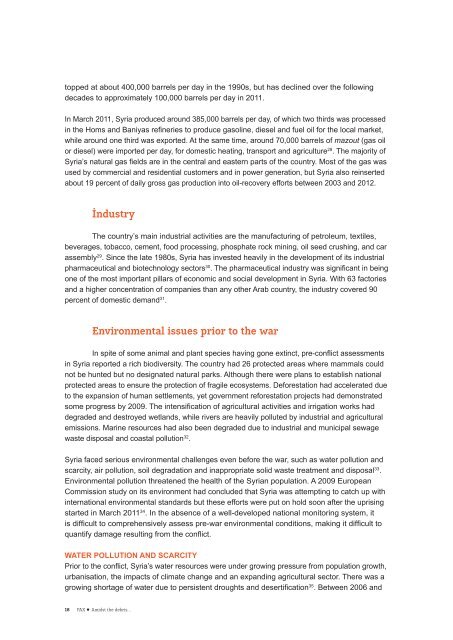Amidst the debris..
pax-report-amidst-the-debris-syria-web
pax-report-amidst-the-debris-syria-web
Create successful ePaper yourself
Turn your PDF publications into a flip-book with our unique Google optimized e-Paper software.
topped at about 400,000 barrels per day in <strong>the</strong> 1990s, but has declined over <strong>the</strong> following<br />
decades to approximately 100,000 barrels per day in 2011.<br />
In March 2011, Syria produced around 385,000 barrels per day, of which two thirds was processed<br />
in <strong>the</strong> Homs and Baniyas refineries to produce gasoline, diesel and fuel oil for <strong>the</strong> local market,<br />
while around one third was exported. At <strong>the</strong> same time, around 70,000 barrels of mazout (gas oil<br />
or diesel) were imported per day, for domestic heating, transport and agriculture 28 . The majority of<br />
Syria’s natural gas fields are in <strong>the</strong> central and eastern parts of <strong>the</strong> country. Most of <strong>the</strong> gas was<br />
used by commercial and residential customers and in power generation, but Syria also reinserted<br />
about 19 percent of daily gross gas production into oil-recovery efforts between 2003 and 2012.<br />
Industry<br />
The country’s main industrial activities are <strong>the</strong> manufacturing of petroleum, textiles,<br />
beverages, tobacco, cement, food processing, phosphate rock mining, oil seed crushing, and car<br />
assembly 29 . Since <strong>the</strong> late 1980s, Syria has invested heavily in <strong>the</strong> development of its industrial<br />
pharmaceutical and biotechnology sectors 30 . The pharmaceutical industry was significant in being<br />
one of <strong>the</strong> most important pillars of economic and social development in Syria. With 63 factories<br />
and a higher concentration of companies than any o<strong>the</strong>r Arab country, <strong>the</strong> industry covered 90<br />
percent of domestic demand 31 .<br />
Environmental issues prior to <strong>the</strong> war<br />
In spite of some animal and plant species having gone extinct, pre-conflict assessments<br />
in Syria reported a rich biodiversity. The country had 26 protected areas where mammals could<br />
not be hunted but no designated natural parks. Although <strong>the</strong>re were plans to establish national<br />
protected areas to ensure <strong>the</strong> protection of fragile ecosystems. Deforestation had accelerated due<br />
to <strong>the</strong> expansion of human settlements, yet government reforestation projects had demonstrated<br />
some progress by 2009. The intensification of agricultural activities and irrigation works had<br />
degraded and destroyed wetlands, while rivers are heavily polluted by industrial and agricultural<br />
emissions. Marine resources had also been degraded due to industrial and municipal sewage<br />
waste disposal and coastal pollution 32 .<br />
Syria faced serious environmental challenges even before <strong>the</strong> war, such as water pollution and<br />
scarcity, air pollution, soil degradation and inappropriate solid waste treatment and disposal 33 .<br />
Environmental pollution threatened <strong>the</strong> health of <strong>the</strong> Syrian population. A 2009 European<br />
Commission study on its environment had concluded that Syria was attempting to catch up with<br />
international environmental standards but <strong>the</strong>se efforts were put on hold soon after <strong>the</strong> uprising<br />
started in March 2011 34 . In <strong>the</strong> absence of a well-developed national monitoring system, it<br />
is difficult to comprehensively assess pre-war environmental conditions, making it difficult to<br />
quantify damage resulting from <strong>the</strong> conflict.<br />
WATER POLLUTION AND SCARCITY<br />
Prior to <strong>the</strong> conflict, Syria’s water resources were under growing pressure from population growth,<br />
urbanisation, <strong>the</strong> impacts of climate change and an expanding agricultural sector. There was a<br />
growing shortage of water due to persistent droughts and desertification 35 . Between 2006 and<br />
18 PAX ! <strong>Amidst</strong> <strong>the</strong> <strong>debris</strong>...


